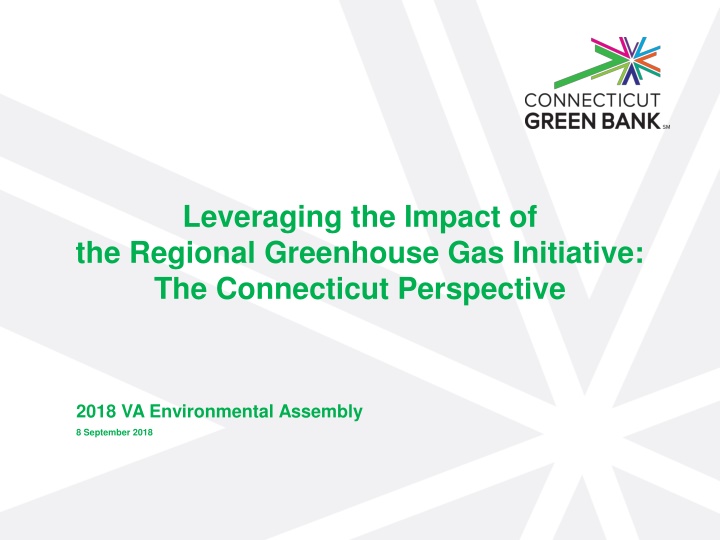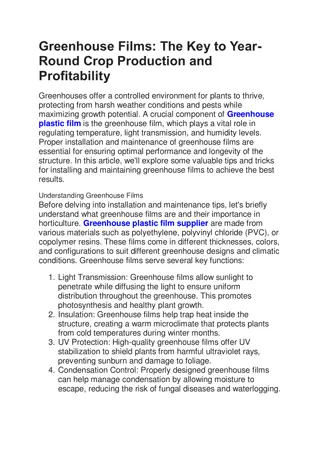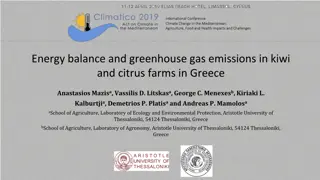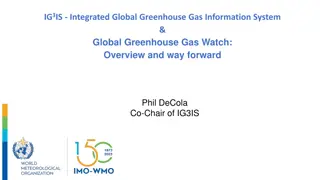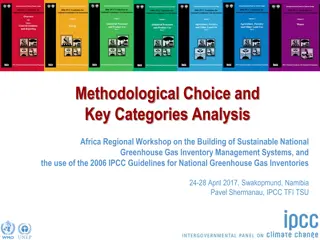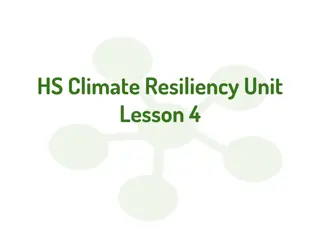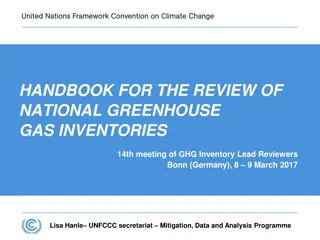Leveraging the Impact of the Regional Greenhouse Gas Initiative in Connecticut
Connecticut serves as a microcosm of the United States, facing significant energy challenges and environmental concerns. The state has adopted various approaches to climate policy, setting ambitious environmental goals such as reducing greenhouse gas emissions and promoting renewable energy sources. By leveraging the Regional Greenhouse Gas Initiative (RGGI) and implementing effective strategies, Connecticut aims to improve its economy, environment, public health, and energy security for both the present and future generations. The administration of RGGI in Connecticut is overseen by the Department of Energy and Environmental Protection (CT-DEEP), which manages the state's CO2 Budget Trading Program and allocates funds to support green initiatives.
Download Presentation

Please find below an Image/Link to download the presentation.
The content on the website is provided AS IS for your information and personal use only. It may not be sold, licensed, or shared on other websites without obtaining consent from the author.If you encounter any issues during the download, it is possible that the publisher has removed the file from their server.
You are allowed to download the files provided on this website for personal or commercial use, subject to the condition that they are used lawfully. All files are the property of their respective owners.
The content on the website is provided AS IS for your information and personal use only. It may not be sold, licensed, or shared on other websites without obtaining consent from the author.
E N D
Presentation Transcript
Leveraging the Impact of the Regional Greenhouse Gas Initiative: The Connecticut Perspective 2018 VA Environmental Assembly 8 September 2018
Connecticut Microcosm of the United States Region New England Population 3.6 million Gross State Product ~$225 B (#3 2015) Buildings some of the oldest, most energy inefficient, and health & safety issues Energy Costs one of the highest electricity costs in USA ( Top 5 ) Grid Reliability major storms routinely cause long-durational power outages 2 2
CT Approaches to Climate Policy Comprehensive Energy Strategy (every 3 yrs) Governor s Council on Climate Change Regional Greenhouse Gas Initiative ( founding state ) ZEV MOU 8 states Energy Efficiency Fund (Jan 2000) Clean Energy Fund (July 2004) CT Green Bank (July 2011) United State Climate Alliance (2017) Renewable & Energy Efficiency Business Association (REEBA) 3
CT Key Environmental Goals GHG Reduction Targets 2010 Target Attain 1990 Level (43.75 MMT CO2) Achieved 2010 2020 Target 10% below 1990 Level by 2020 @ 4% below (2013) 2030 Target New 45% below 2001 Level* by 2030 @ 14% below (2013) 2050 Target 80% below 2001 Level by 2050 Renewable Portfolio Standard Previously 20% by 2020 New 40% by 2040 Zero Emission Vehicles 5% of all vehicles by 2025 (currently 0.15%) % of Fleet to reach GHG Goal (45% below by 2030 & 80% below by 2050) 2020 3% 2030 32% 2050 95% ZEV MOU Mandate * 46.25 MMT CO2 (2001 Level) 4
WHY? Good for the Economy Good for the Environment Good for Public Health Good for Energy Security GOOD FOR OUR PRESENT GOOD FOR OUR FUTURE 5
Administration of RGGI (CT-DEEP ) CT established its individual CO2 Budget Trading Program by regulations based on the RGGI Model Rule. CT s CO2 Budget Trading Program limits emissions of CO2 from electric power plants, issues CO2 allowances, and establishes participation in the RGGI auctions. After approval of each auction s results by agency heads of every RGGI state, RGGI allocates each state s share of RGGI auction proceeds relative to the number of CO2 allowances each state had offered and sold for that auction. DEEP receives the funds from RGGI Inc. DEEP is responsible for handling the allocation of funds to the Green Bank & utility funds. A number of personnel at DEEP comprise CT s RGGI team, and are tasked accordingly to participate in ongoing periodic committees throughout each year. 6
$225.1m (Auctions 37-40) $15.4m (CT Share) CT RGGI Allocation CGB (old CCEF) DEEP CEEF 69.5% $10.7m 7.5% $1.2m 23% $3.5m $10m 8 General Fund FY2018 & 2019
Public Sources & Uses for CT Energy Efficiency & RE Programs * Public Sources & Uses for CT Energy Efficiency & RE Programs * Residential Solar Incentives NE ISO Proceeds ($43m) Energy Efficiency Incentives System Benefit Charges (utility bills) $193m $27m RECs Banks/Credit Unions Private Equity Other Investors Foundations Grants Energy Efficiency Fund CT Green Bank (Clean Energy Fund) $3.5m $10.7m Subsidized Financing Programs Market Financing Programs RGGI Proceeds 9 * Excludes municipal utilities (6.25% of the RGGI proceeds allocated to utilities)
2017 Statewide EE Programs 1 0 10
Connecticut Green Bank Delivering Results for Connecticut Investment mobilized over $1.3 billion of investment into Connecticut s clean energy economy while raising nearly $50 million in state and local tax revenues Jobs created nearly 16,000 total job-years 6,200 direct and 9,700 indirect and induced Energy Burden reducing the energy burden on over 30,000 households and businesses Clean Energy deployed more than 285 MW of clean renewable energy helping to reduce over 4.6 million tons of greenhouse gas emissions that cause climate change Private investment drives economic growth Creates jobs, lowers energy costs, and generates tax revenues 11 REFERENCES CT Green Bank data warehouse report from July 1, 2011 through June 30, 2018
Connecticut Green Bank Innovations in American Government Awards 2017 12
How Green Banks Leverage Public Capital with More Private Capital Credit Support Co-Investment Warehousing Projects Green Bank Capital Senior Private Capital Green Bank Credit Enhancement Green Bank Origination Project(s) Projects $13 Sale of Portfolio or Funding Facility Private Capital Project(s) 13
How Green Banks Leverage Public Capital with More Private Capital Credit Support Co-Investment Warehousing 14
Thank You! Bert Hunter EVP / Chief Investment Officer 845 Brook Street Rocky Hill, CT 06067 bert.hunter@ctgreenbank.com
